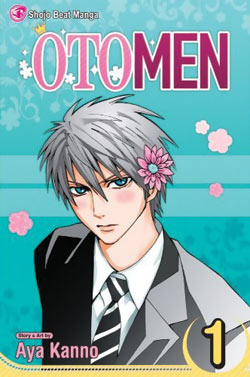To a casual observer, Asuka Masamune epitomizes masculinity. Not only is he the captain of the kendo team and a star student, he’s also tall, handsome, and quick to defend weaker students from bullies — the kind of stoic, principled guy that boys and girls admire. That macho exterior belies Asuka’s true nature as a sensitive young man with girly hobbies such as making elaborate bento boxes, sewing stuffed animals (the cuter, the better), and reading Love Chick, a shojo manga serialized in his favorite magazine, Hana to Mame (literally, “Flowers and Beans,” a pun on Hana to Yume, or “Flowers and Dreams”).
Asuka’s charade is threated by classmate Juta Tachibana, a tousle-haired player who discovers Asuka’s big secret: an unrequited crush on transfer student Ryo Miyakozuka. Ryo is yin to Asuka’s yang, a pretty young woman who can deliver a mean karate chop but can’t bake a cake or sew a button onto a blouse. They may seem like a match made in shojo heaven, but there’s a catch: Ryo disdains “girly” guys. Her initial impression of Asuka is favorable, but that encounter unleashes a torrent of emotion inside Asuka that makes it increasingly difficult for him to play the cool, macho customer. Juta pledges to help Asuka win Ryo — a gesture that initially seems out of character for such a transparent opportunist and womanizer. As we begin to learn more about Juta, however, we discover that he is, in fact, the manga-ka behind Love Chick (he uses the pseudonym “Jewel Tachibana”) and that Asuka is the inspiration for the series’ graceful heroine. Whether Juta empathizes with his subject, or is hoping to manipulate Asuka’s life for literary fodder, isn’t yet clear, though Juta embraces his matchmaking role with gusto.
The set-up is ripe with possibility, but I wasn’t entirely sold on Otomen after reading the first volume. Aya Kanno earned points for her sensitive portrayal of Asuka and gentle digs at shojo cliche, yet the story lacked the necessary edge to be a true satire. Her characters expressed disdain for various shojo conventions while engaged in stereotypical shojo behaviors — meeting on rooftops, exchanging bento boxes, visiting amusement parks. Kanno enlivened these stock scenarios with a generous helping of slapstick, but they never quite rose to the delirious, gender-bending heights of Your and My Secret or My Heavenly Hockey Club.
Volume two suffers from the same have-cake-and-eat-it-too problem, as Kanno trots out more subplots from the shojo playbook: a Christmas date, a surprise fiancee. As with the amusement park trip in volume one, Kanno pokes fun at these familiar scenarios by piling on the misunderstandings and the fist-fights. When Asuka meets his fiancee, for example, he’s initially enchanted by her girly clothing and Disney-fied living quarters. He sticks to his guns, however, and declares his love for Ryo, setting off a chain of events that culminates in a daring rescue by Ryo and Asuka. Yet aside from inverting the usual rescuer/rescuee roles, this scene feels like it could have been lifted from almost any wacky shojo romance; Kanno can’t quite bring herself to skewer this very creaky plot device even as she paints a ridiculous scene.
Otomen is at its best when tackling gender identity head-on. In volume two, for example, Kanno introduces a character named Yamato Ariake, an underclassman who suffers from the opposite problem as Asuka: his petite, pretty appearance leads many folks to assume he’s a girl, even though Yamato has conventionally masculine tastes. He “apprentices” himself to Asuka to learn how to be more manly, gushing about Asuka’s height, gait, and reserved demeanor with infatuated abandon. Yet Yamato expresses disgust when he discovers Asuka’s affinity for cute bento boxes and “girly” activities: how could someone as cool as Asuka be so feminine? On one level, the Yamato-Asuka relationship is a send-up of the “sempai” crush so prevalent in shojo manga; as Yamato catalogues Asuka’s best features, for example, Yamato’s saucer eyes sparkle with the intensity of a Moto Hagio character’s. On another level, however, Yamato’s plight helps underscore just how difficult it is to find a niche when your appearance or personality deviate from established gender norms.
Kanno drives the point home by showing us the degree to which Asuka’s thoughts and feelings reflect his feminine avocations. Using shojo manga tropes — flowery backgrounds, sparkling screentones, close-ups — she demonstrates that Love Chick has profoundly influenced the way in which Asuka fantasizes about Ryo, as he imagines an ideal Christmas Eve date that involves a tender exchange of words and a chaste kiss — hardly the stuff of harem comedies. She also uses these time-honored techniques to help us understand Asuka’s ambivalent feelings about his father, who abandoned the family to have a sex change operation. As we learn in volume one, his dad harbored a similar interest in girly things; his departure inspired Asuka’s mother to purge the cute and sparkly from Asuka’s life, lest he also turn out to be a woman in a man’s body. Though the flashbacks to Asuka’s childhood border on melodrama, the way in which they’re drawn gives them a poignancy and immediacy that mitigates against camp.
I’m not sure on which side of the drama/satire divide Otomen will settle, but I certainly plan to continue reading this odd, funny, and sometimes moving tribute to a character who’s man enough to excel at kendo and like shojo and stuffed animals.
Review copies provided by VIZ Media, LLC.
OTOMEN, VOLS. 1-2 • BY AYA KANNO • VIZ • RATING: TEEN




cindaflame says:
I just picked this up today. It is tears in your eyes fall down funny. The situations the characters get themselves into are hilarious.
I am so looking forward to the live action drama of this when it comes out in August!
Katherine Dacey says:
I didn’t know there was a live-action drama in the works — thanks for the heads up!